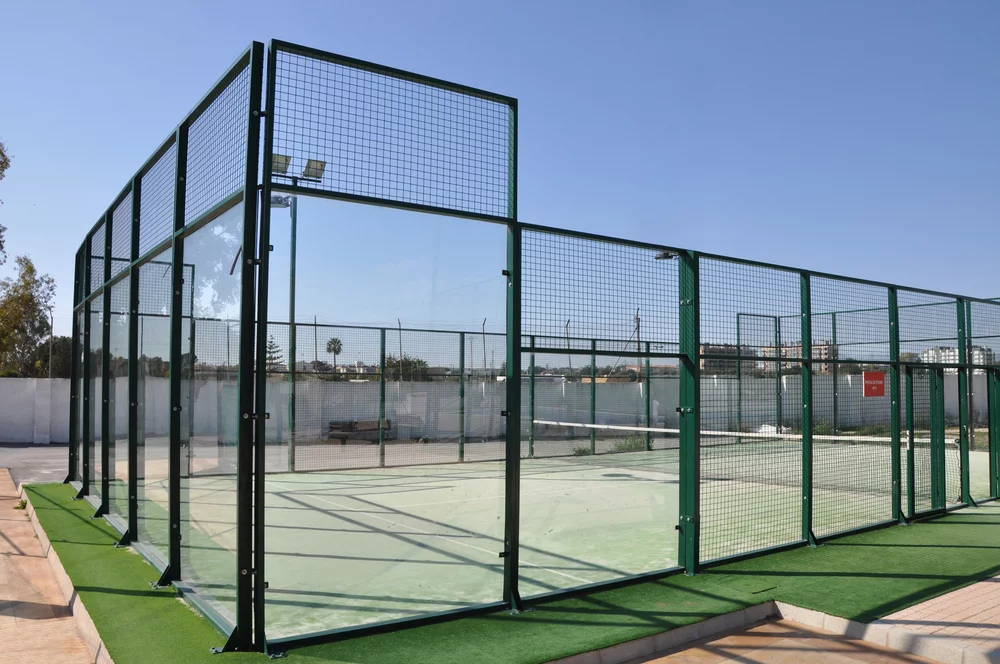Padel has a number of special technical aspects that need to be mastered, including the use of “grillage” in play. Understanding and applying the padel grillage rule in match play is essential to optimising your performance and ensuring that your competition complies with official standards. In this article, we’ll explore the grilling rule, its specifics and how it applies in a match situation.
What is fencing in padel?
The padel court is surrounded by walls, often made of glass, and metal fencing. These structures form the boundaries of the court and play a crucial role in the game. The “grillage” or “fence” allows the ball to be returned strategically. Unlike tennis, where the ball has to remain in a more traditional game, in padel the ball can bounce off the walls and fences after an initial rebound off the ground.
Basic rules for using fencing
In padel, there are certain precise rules governing the use of the grid. Here are the essential points:
- After a ground bounce, the ball may touch the walls and the mesh before being hit by the opponent. This includes balls that bounce off the ground and hit the fence directly.
- The ball cannot hit the net directly from a serve. A valid serve must first bounce into the opponent’s service area before hitting the net or wall.
- During a rally, if the ball hits the net or the walls without first bouncing on the floor, it is declared a fault.
- Once the ball has been struck, it may touch the grid on its own side after bouncing on the ground. However, if it bounces on the other side of the court, it must touch the opponent’s court before it can touch anything else.
Special cases and exceptions
There are certain specific situations that may arise during a match. These require a good understanding of the grid rule to avoid disputes:
- If a ball bounces off the floor, hits the wall, then crosses the net and hits the opponent’s net, the player may continue the rally as long as the ball has touched the floor before hitting the wall or net.
- When a ball bounces against the wall or the net and comes back into play without crossing the net, the opponent can still hit the ball, but this becomes complex from a strategic point of view.
- If a ball touches the net before hitting the opponent’s fence after bouncing, it is considered to be in play and not a foul.
Strategic impact of the net in play
The net is not just a wall, it is also a strategic asset. Using its characteristics helps to create unexpected angles and destabilise your opponent. Here are some common tactics:
- Cushioned balls: A soft ball that hits the net after a slight bounce can surprise a player, particularly effective when the opponent is a long way from the net.
- Lob shots: By using the net to cushion and direct a high ball, you can force your opponent to step back and weaken his position.
- Cross shots: Hitting the ball towards a side wall so that it bounces and hits the net on the opposite side can create an unpredictable and unnerving trajectory.
Defensive play with fencing
Fences aren’t just for attacking. It also offers opportunities to defend yourself in difficult situations:
- If you’re stuck at the back of the court, using the net to return a high, long ball is a good option for regaining an advantageous position.
- Shots against the walls or fencing can slow down the pace of play, giving you time to reposition your strategy and prepare to return an attack.
- In the event of an opponent’s smash, anticipating the bounce of the fence to keep the ball in play allows you to recover and remain competitive in the rally.
The role of the referees in applying the fencing rule
In an official match, the presence of a referee is crucial to ensure that the rules concerning grills are respected. Their role is to check that
- That the ball has bounced on the ground before touching the fence or walls.
- That the serves comply with the rules, in particular as regards the prohibition on hitting the fence directly.
- Potential disputes arising from bounces on different surfaces.
The referees have the authority to determine whether points should be replayed if there is any doubt or confusion about the application of the rules relating to the grid.
Importance of good communication between partners
As padel is a team sport, it is vital that partners communicate and coordinate effectively, especially when using the grid rule:
- Anticipating shots: Knowing possible angles and trajectories helps you to position yourself better.
- Ball calls: Signalling to your partner that you’re taking the shot can avoid collisions or stray balls.
- Technology and video analysis: Use match recordings to spot mistakes and improve the use of the grid, adjusting strategies accordingly.
Mastering the grid to excel at padel tennis
Mastering the application of the padel grillage rule in matches is not just a question of complying with regulations. It’s also an opportunity to enrich your game and develop innovative strategies. Precise knowledge of the rules, combined with regular practice, will enable you to take advantage of grills in both defensive and offensive phases. Incorporating these skills into your repertoire will significantly improve your performance in matches. For quality padel equipment and accessories, take a look at our selection at Bandeja Shop. We offer a wide range of products to meet all your needs, whatever your level of play.

